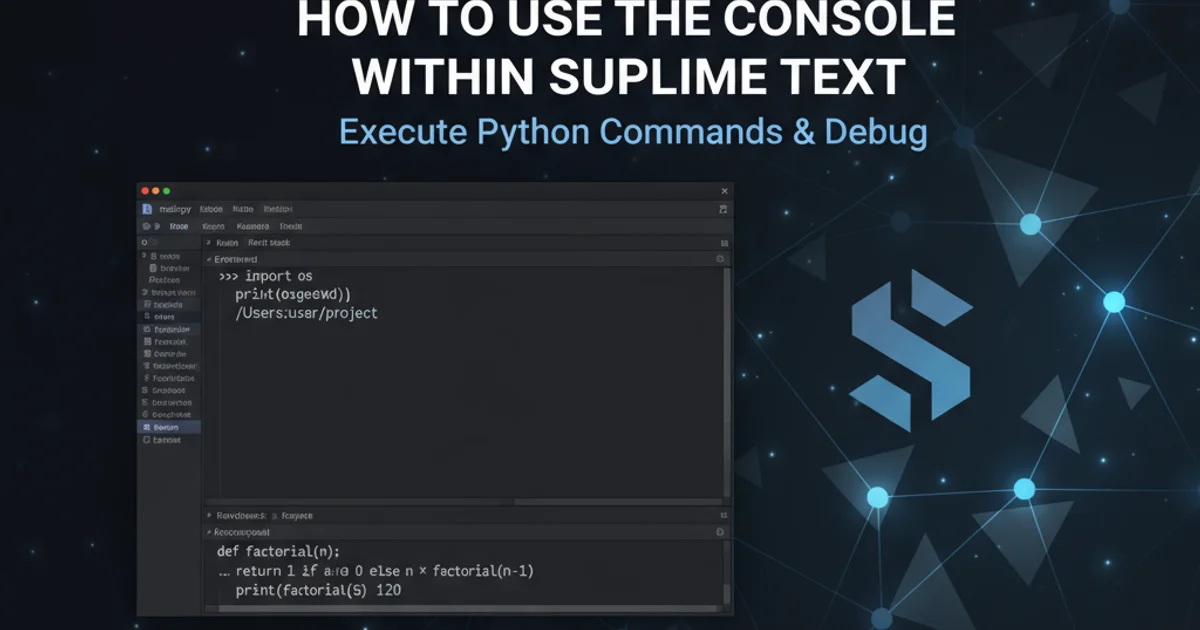How to use the console within Sublime Text
Categories:
Mastering the Sublime Text Console for Enhanced Productivity

Unlock the power of Sublime Text's built-in console for debugging, executing Python commands, and interacting with the editor programmatically. Learn how to leverage this often-overlooked feature to streamline your workflow and extend editor functionality.
Sublime Text is renowned for its speed, efficiency, and extensibility. While many users are familiar with its vast array of shortcuts and packages, the built-in console often remains an untapped resource. This powerful tool allows you to execute Python code directly within the editor, inspect editor state, debug plugins, and even interact with the Sublime Text API. Understanding how to effectively use the console can significantly boost your productivity and provide deeper insights into how Sublime Text operates.
Accessing and Understanding the Console
The Sublime Text console is a Python interpreter embedded within the editor. It's an invaluable tool for developers and power users alike, offering a direct line to the editor's core. You can use it to test snippets of Python code, inspect variables, or even manipulate the current view and selection. The console is particularly useful for plugin development, allowing you to debug and test your code in real-time without restarting the editor.
1. Opening the Console
To open the console, navigate to View > Show Console in the menu bar, or use the keyboard shortcut Ctrl+\ (Windows/Linux) or Cmd+` (macOS). A panel will appear at the bottom of your Sublime Text window.
2. Executing Commands
Once open, you'll see a prompt >>>. This indicates that the console is ready to accept Python commands. Type your Python code here and press Enter to execute it. For multi-line commands, press Shift+Enter to add a new line without executing.
3. Interacting with the Editor
The console provides access to the sublime module and the current window and view objects, allowing you to interact directly with the editor's state. For example, you can get the current file name or insert text.
import sublime
import sublime_plugin
# Get the current window and view
window = sublime.active_window()
view = window.active_view()
# Print the file name of the current view
print(view.file_name())
# Insert text at the current cursor position
view.run_command("insert", {"characters": "Hello from console!"})
Basic Python commands to interact with Sublime Text via the console
Debugging Plugins and Exploring the API
For plugin developers, the console is an indispensable debugging tool. You can import your plugin modules, call functions, and inspect variables directly. This allows for rapid iteration and testing without the overhead of constantly reloading the plugin or restarting Sublime Text. Furthermore, it's an excellent way to explore the Sublime Text API, experimenting with different methods and understanding their return values.
flowchart TD
A[Open Sublime Console] --> B{Execute Python Code}
B --> C{Interact with `sublime` module}
C --> D{Access `window` and `view` objects}
D --> E[Manipulate Editor State]
E --> F{Debug Plugins}
F --> G[Explore Sublime API]
G --> H[Enhance Productivity]Workflow for using the Sublime Text console
# Example of debugging a hypothetical plugin function
# Assuming you have a plugin file named 'MyPlugin.py' in your Packages folder
import sys
# Reload the plugin module (useful during development)
if 'MyPlugin' in sys.modules:
del sys.modules['MyPlugin']
import MyPlugin
# Call a function from your plugin
MyPlugin.my_test_function("console_input")
# Inspect a variable from your plugin
print(MyPlugin.last_result)
Debugging a Sublime Text plugin using the console
Advanced Console Usage and Tips
Beyond basic command execution, the console offers several advanced features. You can paste multi-line code blocks, use tab-completion for sublime module objects (though it's not as robust as a full IDE), and even redirect output to a file for logging purposes. For more complex interactions, consider writing a temporary plugin command and executing it via view.run_command() from the console.
# Example: Listing all available commands
# This can be useful for discovering new editor functionalities
import sublime
for command in sublime.find_commands_with_text():
print(command)
Listing all available Sublime Text commands via the console
The Sublime Text console is a versatile and powerful feature that, once mastered, can significantly enhance your interaction with the editor. Whether you're a casual user looking to quickly test a Python snippet or a seasoned plugin developer debugging complex logic, the console provides a direct and efficient interface to Sublime Text's internals.